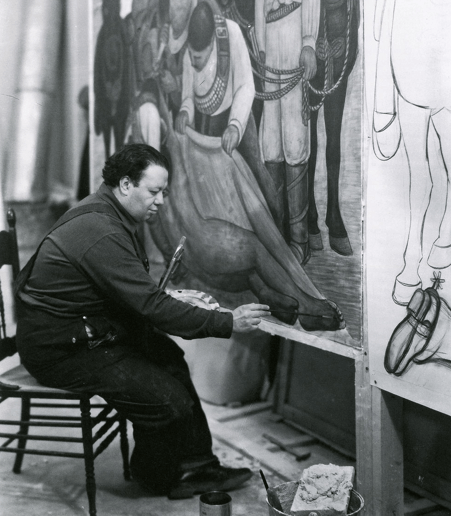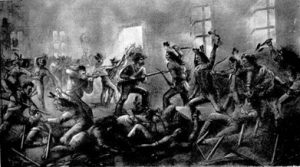Winner of the Spring 2017 StMU History Media Awards for
Best Article in the Category of “Culture”
When entering a Mexican restaurant today, one takes notice of the different aromas, both sweet and savory; one notices the patrons often speaking their language of Spanish; one hears the vibrant tunes of a jukebox; however, one might ask whether the art hanging on the walls of the restaurant isn’t also worthy of the patrons’ attention? One may have seen the famous work of art depicting a woman of colored skin, brown as sugar, contrasting with the white of beautiful calla lilies; or, if not, one might at least be familiar with another work by that same painter.1 The name of this artist, who is known far beyond the Mexican restaurants that hang his famous paintings and murals, is Diego Rivera.

Born in Guanajuato, Mexico, on December 8, 1886, Rivera grew up always seeming to have a hand for creating art. As a child, he had his own studio to work in and later he was granted a scholarship that allowed him to take his talent to Europe, especially to France, where he spent ten years expanding and perfecting his techniques. He is best known for his many influential murals and paintings that illustrate the struggles and lifestyles of the Mexican working class. Among his most famous murals is The History of Mexico from the Conquest to 1930, housed in the National Palace in Mexico City; The Making of a Fresco in San Francisco; and Detroit Industry, located in the city that was home to the American industrial worker in the early twentieth century.2

In the autumn of 1922, Rivera joined the Mexican Communist Party. This organization positively impacted the Mexican community through supporting miners’, factory workers’, and farmers’ rights. With the support of those miners, factory workers, and farmers, Rivera formed the Union of Technical Workers, Painters, and Sculptors. Through the Union, Rivera opened free art schools all over Mexico, through which he was able to spark the Mexican mural movement, enabling his protégés to showcase their art, inspired by Rivera’s own murals. Rivera became well-known in Mexico, and even people from different countries came to his Union to participate.3

In 1929, Rivera began working on a series of frescoes titled History of Mexico from the Conquest to 1930. The art piece took twenty years to complete because of minor adjustments and additions, and he also worked on other pieces in the interim. However, during this time of his busiest artistic activity, he was expelled from the Mexican Communist Party for being “too busy” painting. Despite his expulsion, he continued to favor the working class and always believed he was one of them.4 On February 9, 1934, Nelson Rockefeller was said to have sent workers to destroy a mural located in the Rockefeller Center in New York City, a mural Rivera had spent many weeks painting with smooth precision. The painting was destroyed because of a portrait of Vladimir Lenin painted in the mural, which was not originally in the sketch sent for Rockefeller’s approval. This left Rivera in a state of depression and exhaustion after realizing his hard work was put to waste, without even being given a chance to be named.

Despite the controversies Rivera encountered throughout his career he was still a magnificent painter and influenced much of Mexico’s national art.5 In 1947, another one of Rivera’s murals heated his audience, Dream of a Sunday Afternoon in the Alameda. It was located in the Hotel del Prado across the street from Alameda and the painting covered the history of the park and its peoples (from Rivera’s perspective) all the way from the years of the Spanish Inquisition to the Mexican Revolution. The reason it sparked criticism and caused demonstrators to slash the fresco was because the words “God does not exist” were written in the mural. Rivera, of course, repaired the damages made. In 1956, a year before his death, he announced “I am a Catholic,” and changed the wording on the fresco.6 It was among one of the last great murals he painted. But despite the controversies that Rivera encountered throughout his career, he was still a magnificent painter and influenced much of Mexico’s national art.7

In addition to being a hard worker and a talented painter, Rivera was also great with the ladies. While in Paris he first became engaged to a Russian artist named Angelina Beloff, with whom he had a son, Diego Jr., who unfortunately died at fourteen months from the influenza epidemic of 1919-1920.8 In 1921, he returned to Mexico, where he met a fine beauty from Guadalajara named Lupe Marin. Just a short year later they were married, leaving Angelina in Paris still believing that they were engaged. In the years that followed, Marin bore Diego two daughters, Guadalupe and Ruth.9 However, his infidelity caused their marriage to fall apart, with Marin left raising their daughters on her own. By 1929, Rivera had already remarried, but this time to the famous Frida Kahlo.10

Rivera was working on a painting in the National Palace in Mexico City when Frida approached him; she requested that he get down from the scaffold and give his honest opinion on her own work. After looking at her work, he called it “an unusual energy of expression,” calling her an authentic artist. She invited him to see more of her work at her home in Coyoacán. From there, a friendship blossomed, and soon they fell in love.11 Their marriage was not like any ordinary marriage; it was an emotional roller coaster of a relationship that was well depicted in both of their works, especially in Kahlo’s. She accompanied him everywhere: San Francisco, New York, Detroit, and many other places. They managed for many years, up until Rivera became involved with Frida’s younger sister. They then divorced in 1940.

During this time, Leon Trotsky (Soviet politician) was a target for many agents of Joseph Stalin and was found in his home with a pickaxe jabbed in his head.12 Previously, Rivera and Frida’s home in Coyoacán served as an asylum for Trotsky and his wife as a refuge from these assassins of Stalin’s. While in their home Casa Azul, Kahlo and Trotsky had an amorous affair, and a subsequent quarrel between him and Rivera.13 Rivera cut off any interaction with Trotsky and fled to San Francisco, where he started working on a mural. The police questioned Kahlo about Trotsky’s death, and she later followed Rivera to San Francisco. They remarried that same year, and despite his infidelities, they continued to be passionately in love. However, in 1954, after fourteen more mercurial years of marriage, Kahlo died, and Rivera mourned her death for a year before marrying his third wife, Emma Hurtado. Diego Rivera had a way with women, and his big belly and smelly self did not get in the way of his passion for both art and women.

Rivera was heavily involved in politics at an early stage of his life and continued to be up until his death. In 1955, he was diagnosed with cancer and traveled all the way from Mexico to Moscow to get treatment. Two years later, on November 24th, he passed away in his home in San Angel, Mexico City, Mexico. He wanted his ashes to be spread alongside those of Frida Kahlo in a templo he built; instead, he was buried. Rivera was head of the Anti-Imperialist League and held memberships in the National Peasant League and the Workers’ and Peasants’ Bloc. Also, he rededicated himself to the Mexican Communist Party in 1926 and was a delegate to the Moscow Peasant Congress in 1936.14 Rivera in many ways resembled the indigenous people of the working class illustrated in his works of art. Not only did they share the same native country, but they too were concerned for the political movement and the aftermath of the Mexican Revolution, and they too had the passion and drive to continue working hard, in both sickness and in health.
- Diego Rivera, “Desnudo con Alcatraces,” painting in oil, 1944, original in Private Collection. ↵
- Susan Goldman Rubin, Diego Rivera: An Artist for the People (New York: Abrams Books for Young Readers, 2013), 6. ↵
- Susan Goldman Rubin, Diego Rivera: An Artist for the People (New York: Abrams Books for Young Readers, 2013), 16. ↵
- Susan Goldman Rubin, Diego Rivera: An Artist for the People (New York: Abrams Books for Young Readers, 2013), 22. ↵
- Susan Goldman Rubin, Diego Rivera: An Artist for the People (New York: Abrams Books for Young Readers, 2013), 26. ↵
- William Stockton, “Rivera Mural in Mexico Awaits it New Shelter,” New York Times, January 4, 1987. Accessed April 17, 2017. http://www.nytimes.com/1987/01/04/arts/rivera-mural-in-mexico-awaits-its-new-shelter.html. ↵
- Susan Goldman Rubin, Diego Rivera: An Artist for the People (New York: Abrams Books for Young Readers, 2013), 26. ↵
- Susan Goldman Rubin, Diego Rivera: An Artist for the People (New York: Abrams Books for Young Readers, 2013), 12-13. ↵
- Susan Goldman Rubin, Diego Rivera: An Artist for the People (New York: Abrams Books for Young Readers, 2013), 16-18. ↵
- Frida Kahlo was an iconic revolutionary Mexican artist widely recognized for her disturbing personal self-portraits of the female body and known for her Tehuana style. See Encyclopedia of Activism and Social Justice, 2007, s.v. “Kahlo, Frida (1907–1954),” by Gary L. Anderson and Kathryn G. Herr. ↵
- Susan Goldman Rubin, Diego Rivera: An Artist for the People (New York: Abrams Books for Young Readers, 2013), 18-21. ↵
- Encyclopedia of Activism and Social Justice, 2007, s.v. “Trotsky, Leon (1879–1940),” by Gary L. Anderson and Kathryn G. Herr. ↵
- Encyclopedia of Sex and Gender, 2007, s.v. “Kahlo, Frida (1907–1954),” by Fedwa Malti-Douglas. ↵
- Encyclopedia of Activism and Social Justice, 2007, s.v. “Rivera, Diego (1886–1957),” by Gary L. Anderson and Kathryn G. Herr. ↵



127 comments
Samuel Stallcup
Rivera’s paintings were around me most of my elementary school years, for our art teacher was greatly influenced by both him and Frida Kahlo. Like many would agree, I feel knowing his story (and also reading this article) is a necessary component to learning the culturally rich history that Mexico has to offer. I think what’s most interesting about this article is that Diego was a member of a “communist” party; I feel most people during this time may have not been quite a fan since the United States was very anti-communist.
Alexandria Martinez
This was a great article, I have always seen that picture of the woman with calla lilies but I never knew who painted that. It was interesting to finally find out after all these years who it was. I never knew much about Diego except that he was a famous painter and reading this article helped me learn a lot more about him, he lived a very interesting life.
Justin Garcia
This is a very eye catching article both through your use of images and work choices. The life of Diego Rivera has always been interesting for me and many others. Many teachers and books focus on the legendary artists from Europe such as Lenoardo da vinci, and Michelangelo. They tend glance over painters from other countries. This article gives more people insight into the life he lead and some background to his art. Overall a great article.
Mark Martinez
A very well written and put together article. I had seen many of these types of painting before in stores as collectables, and on walls as murals. It just never accrued to me hat there might be a connection between them. Its just amazing how Diego Rivera used his passion to start a union for the working people. Even if he had gotten kicked out because of all his time painting.
Crystalrose Quintero
The picture to open up the article was the most capturing photo to open up. It had me wanting to know more about who Diego rivera was. The first paragraph was so captivaring. Every description of his paintings used such illustrative adjectives that really captured what the write was describing. It had some literary devices also such as contrasting two objects in their description. “Good with the ladies” seemed like a very slang or perhaps common thing to say which I enjoyed reading in this article. Overall he really captured every detail with precision and left nothing out.
Sarah Mares
Diego Rivera led a life of many travels (and lovers), and involved himself in situations that would be influential towards his work. The introduction paragraph in this article is written with such truth, it turns out I have seen more of Rivera’s art than I thought I had. I enjoyed reading about the professional and love life of a successful Mexican, despite his many flaws, Rivera was ultimately a man of love.
Valeria Hernandez
Gabriela Medrano explains the life of a Mexican artist who represented his culture and traditions by the use of art. The author does an amazing job at displaying Rivera’s work by creating a timeline of his life. She manages to explain both his professional and personal experiences and tieing a connection of his feeling to his artistic expression. The article is a well-executed narrative of one of the most recognized artists in Mexico and my personal favorite artist.
Miranda Yzaguirre
What intrigued me most about this article was the fact that he publicly announced he was a Catholic; yet, he committed adultery and abandoned many of his children. In the Mexican culture religion is very important so, I found it interesting that he never really faced any backlash for his actions. His rambunctious personality though did not take away from his paintings; it probably intensified them. This article was very interesting overall and the writer did a great job expressing the life and talent of Rivera.
Alejandra Mendez
As a Hispanic and art lover, Diego Rivera is by far one of my favorite artists. In every one of his pieces, he captured the essence of not only Mexican culture but the issues Mexico faced at the time as well. His depictions explained what the country’s status at the time was. Although I knew of some of the basic history of Diego Rivera, this article taught me more than I already knew. It definitely gave me more insight about his life than other articles I’ve read about him because I always focused on his art. I, as most do, only knew of Frida Kahlo but never imagined him having other wives and other children before and after her! His art was and always will be interesting, but I think him as a character is even more interesting now that I have read this article.
Lisa Varela
Great article!! I have always know that the name Diego Rivera usually causes an instant recognition, he is considered a very important figure in Mexican history. I also knew a few facts about his life, but this article gave me a broader picture of his life. When I was in Mexico City I had the opportunity to see his mural, The History of Mexico from the Conquest to 1930 in person, it was huge and very impressive.